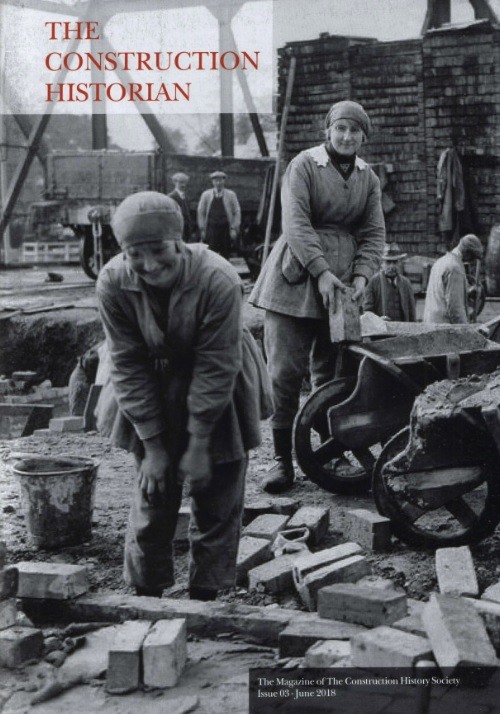The Construction Historian, Issue 9, March 2022
In The Construction Historian (Issue 9, March 2022) Michael Heaton offers a short article entitled ‘Another Fine Mess…’, looking at mistakes (or mistaken understanding) in construction. Heaton observes that engineering history, especially that of vernacular structural carpentry, assumes that craftsmen builders had an innate understanding of the capacity of materials and structures to withstand and transfer the forces created by and operating on the structures they built. As we rarely find, or report, evidence of failures, we assume that structural forms were developed and improved in response to the changing demands of society in careful empirical stages.
In the case of roof trusses for duo-pitched roofs, the many forms developed in Europe during the last c2,000 years all perform the same two functions in slightly different ways: restraining the outward thrust of the pitches under load while, if possible, creating a usable space within the roof (the interrupted tie-beam roof truss is a good example of this). A common truss form in small 19th-century British stables is needed for a usable space in the low-pitched roof for storing feed or staff accommodation. A rigid structural triangle has to resist outward thrust of the loaded principal rafters without needing the full span of the tie-beam that would ordinarily render the roof space difficult to use.
In the case Heaton observed, the carpentry had allowed the roof to spread outwards, threatening the imminent collapse of the building. This demonstrates that, contrary to received engineering history, the designer (or carpenter) of this early-19th-century roof truss did not understand statics. Although assumed to be experienced and competent, they were copying a structural detail they had seen elsewhere, possibly in a book, (that is, fashion) without understanding how it worked, which suggests also not knowing how the traditional forms actually worked.
Also of note is an article by Edwin AR Trout about the Orchestrelle Factory, Benlow Works, in Hayes, Middlesex, a Grade II listed building at risk. The name was closely associated with the fashion of the day for mechanised music (the pianola), and was both the name of a musical instrument and its manufacturer. The four-storey building was designed in 1909 for the Aeolian Organ and Music Company by Walter Cave, with distinctive full-height Diocletian windows. It was constructed in a material new at the time, Stuart’s Granolithic Stone, a form of reinforced concrete. A possible reuse is being explored, but the future of this significant building, described at the time of its construction as ‘one of the most important undertakings in reinforced concrete construction erected in this country… A noteworthy example of the practical use of reinforced concrete for factory construction’ is not yet secured.
This article originally appeared as: ‘The Construction Historian’ in the Institute of Historic Building Conservation’s (IHBC’s) Context 172, published in June 2022. It was written by Bob Kindred MBE.
--Institute of Historic Building Conservation
Related articles on Designing Buildings
IHBC NewsBlog
Old Sarum fire in listed (& disputed) WW1 Hangar - Wiltshire Council has sought legal advice after fire engulfed a listed First World War hangar that was embroiled in a lengthy planning dispute.
UK Antarctic Heritage Trust launches ‘Virtual Visit’ website area
The Trust calls on people to 'Immerse yourself in our heritage – Making Antarctica Accessible'
Southend Council pledge to force Kursaal owners to maintain building
The Council has pledged to use ‘every tool in the toolbox’ if urgent repairs are not carried out.
HE’s Research Magazine publishes a major study of the heritage of England’s suburbs
The article traces the long evolution of an internal programme to research 200 years of suburban growth
IHBC Context 183 Wellbeing and Heritage published
The issue explores issues at the intersection of heritage and wellbeing.
SAVE celebrates 50 years of campaigning 1975-2025
SAVE Britain’s Heritage has announced events across the country to celebrate bringing new life to remarkable buildings.
IHBC Annual School 2025 - Shrewsbury 12-14 June
Themed Heritage in Context – Value: Plan: Change, join in-person or online.
200th Anniversary Celebration of the Modern Railway Planned
The Stockton & Darlington Railway opened on September 27, 1825.
Competence Framework Launched for Sustainability in the Built Environment
The Construction Industry Council (CIC) and the Edge have jointly published the framework.
Historic England Launches Wellbeing Strategy for Heritage
Whether through visiting, volunteering, learning or creative practice, engaging with heritage can strengthen confidence, resilience, hope and social connections.















